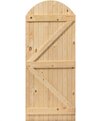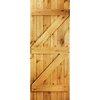You are using an out of date browser. It may not display this or other websites correctly.
You should upgrade or use an alternative browser.
You should upgrade or use an alternative browser.
Angle of a brace
- Thread starter Adam78
- Start date
Sponsored Links
For it to be 45 degrees the door would have to be very short, or very wide.
I do not speak with any authority but surely it need to be a long as it needs to be? The longer the door, the greater the angle will become. I cannot, off the top of my head, work out why any angle under 90 degrees will be an issue.
I do not speak with any authority but surely it need to be a long as it needs to be? The longer the door, the greater the angle will become. I cannot, off the top of my head, work out why any angle under 90 degrees will be an issue.
Use two.
But they should both go in the same direction. From the hinge side upwards to the latch side.
Gives the effect of two Z's sitting one on top of the other with a horizontal bar running between them.
In the case below, the hinges would be on the left side.
Attachments
Sponsored Links
But they should both go in the same direction. From the hinge side upwards to the latch side.
Gives the effect of two Z's sitting one on top of the other with a horizontal bar running between them.
In the case below, the hinges would be on the left side.
I had an LBF made, pretty well I think, and it still sagged.
I've come to the view that they ought to be made, with the lock style an inch or so higher than the hinge side, so they can sag a bit and load up the braces.
rather like making pre-stressed concrete
They can be made either wayBut they should both go in the same direction. From the hinge side upwards to the latch side.
Gives the effect of two Z's sitting one on top of the other with a horizontal bar running between them.
In the case below, the hinges would be on the left side.
D
Deleted member 174758
But did you just leave the end of the diagonals cut flat?I had an LBF made, pretty well I think, and it still sagged.
or did you seat the ends of the brace in notches cut into the ledges to stop them moving?
That's one of two methods I was taught - the other is this:
The "modern" way of not putting a notch in there puts all the strain from the brace into the planks alone, and of course planks can swell or shrink (especially if they are outdoors), so the gate is more likely to droop if you don't add that notch. The fact is that ledged and braced gates will always droop a little, but notching the ends of the diagonal bracesn reduces the tendency, but if you want to avoid that completely you need to go to something like a framed, ledged and braced frame with a planked cladding which is a lot more work
That's not what I was taught - and not what I've taught apprentices, either. The braces should always run diagonally upwards away from the hingesThey can be made either way
Last edited by a moderator:
I do know about the slanting pockets for the ends of the brace, but it was made for me by a skilled-seeming young local joiner who cut them flat.
I re-hung it upside down about a year ago and have it in mind to add a studding or cable tensioner from top hinge side to bottom lock side.
I re-hung it upside down about a year ago and have it in mind to add a studding or cable tensioner from top hinge side to bottom lock side.
But did you just leave the end of the diagonals cut flat?
View attachment 276784
or did you seat the ends of the brace in notches cut into the ledges to stop them moving?
That's not what I was taught - and not what I've taught apprentices, either. The braces should always run diagonally upwards away from the hinges
Yes, thats what we were taught in woodwork at school and the way I have made them.
you need to go to something like a framed, ledged and braced frame with a planked cladding
...which I have
braces on the correct diagonal
T&G rail joints, too
D
Deleted member 174758
They don't teach them the way they used to (NVQs aren't C&Gs) - it's all about throw it in, get the money and beggar off these days...I do know about the slanting pockets for the ends of the brace, but it was made for me by a skilled-seeming young local joiner who cut them flat.
D
Deleted member 174758
Add more weight and the extra weight might cause the droop to get worse.I... ...have it in mind to add a studding or cable tensioner from top hinge side to bottom lock side.
Was your guy clued up enough to nail the gate together and clench them over?
Last edited by a moderator:
DIYnot Local
Staff member
If you need to find a tradesperson to get your job done, please try our local search below, or if you are doing it yourself you can find suppliers local to you.
Select the supplier or trade you require, enter your location to begin your search.
Please select a service and enter a location to continue...
Are you a trade or supplier? You can create your listing free at DIYnot Local
Sponsored Links
Similar threads
- Replies
- 10
- Views
- 2K
- Replies
- 16
- Views
- 2K
D
- Replies
- 11
- Views
- 5K
- Replies
- 6
- Views
- 3K
D




